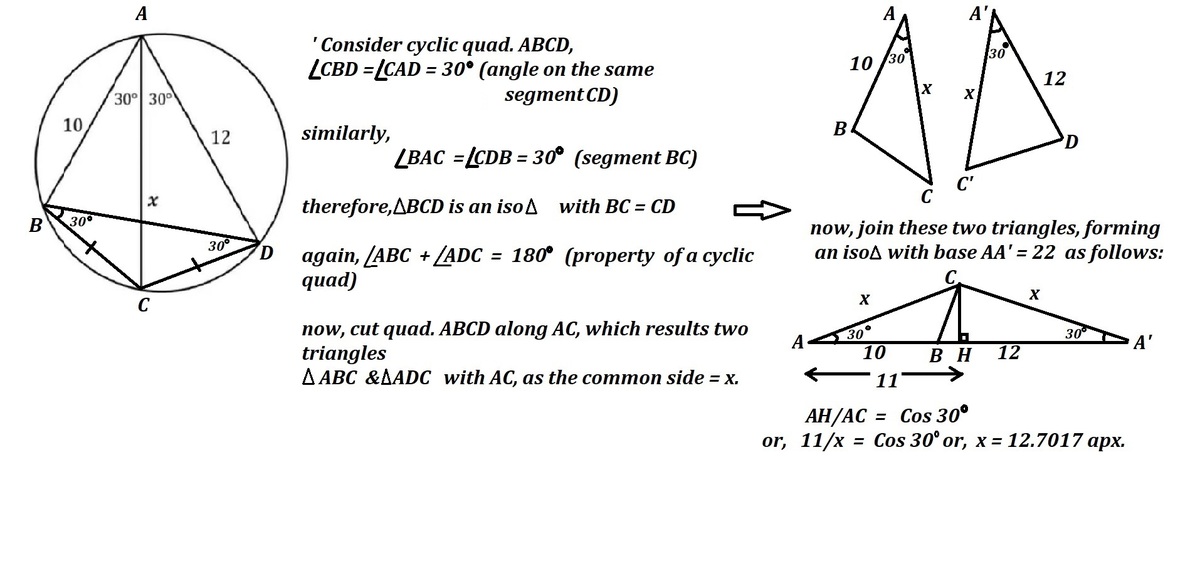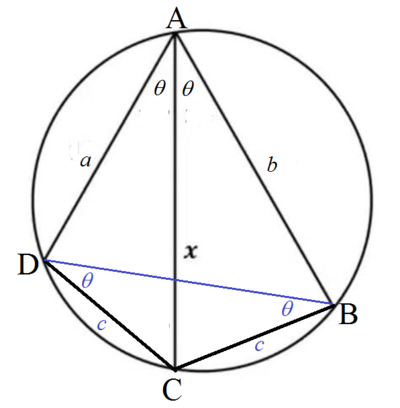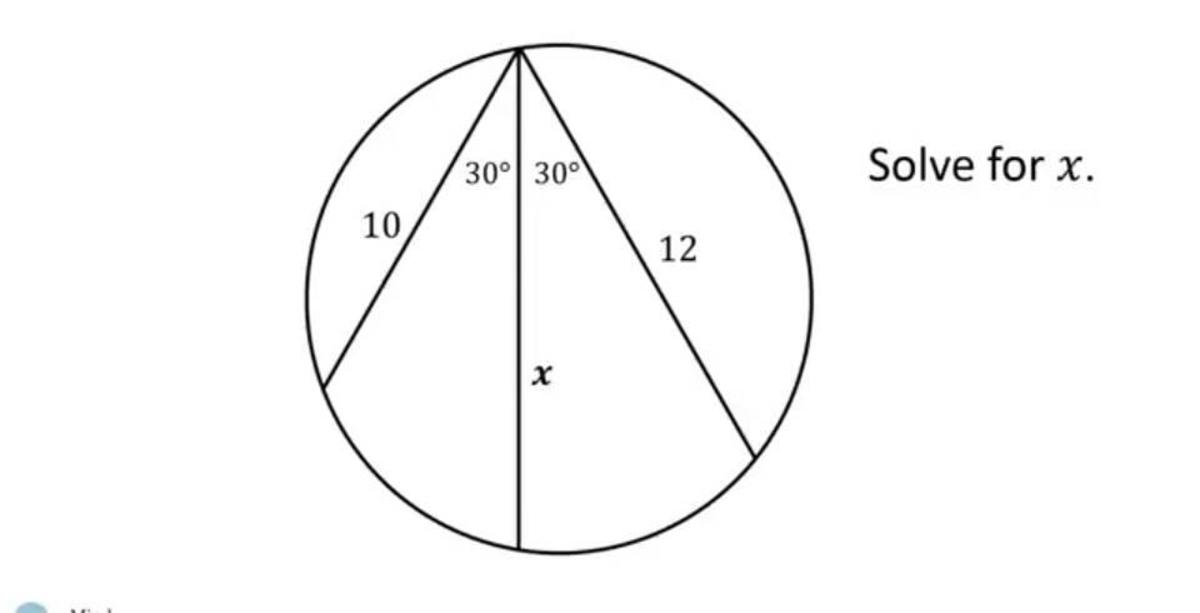This section requires Javascript.
You are seeing this because something didn't load right. We suggest you, (a) try
refreshing the page, (b) enabling javascript if it is disabled on your browser and,
finally, (c)
loading the
non-javascript version of this page
. We're sorry about the hassle.
4 solutions

can u help.. https://brilliant.org/discussions/thread/how-to-approach-this-question/
Let the radius of the circle be r . Then cos 3 0 ° = 2 √ 3 = 2 0 x 1 0 0 + x 2 − r 2 = 2 4 x 1 4 4 + x 2 − r 2 . Or 2 √ 3 x = 4 4 or x = √ 3 2 2 = 1 2 . 7 0 1 7 . . .
Refer to the diagram of Chew-Seong Cheong. Let O be the centre of the circle. Note that / DOC=60°. Also / BOC=60° which make Tr. DOC & Tr. BOC equilateral and hence DC=BC=r. Then it follows from Tr. ADC that: √3/2 = (100+x²-r²)/(20x). Likewise, from Tr. ABC: √3/2 = (144+x²-r²)/(24x). Solve the two equations to get x=22/√3. Nice solution Alak Bhattacharya.

Providing a general solution as suggested by @Nikola Alfredi . Therefore, instead of 1 0 , 1 2 , and 3 0 ∘ , we have a , b , and θ respectively.
Since A B C D is a cyclic quadrilateral , then ∠ B A C = ∠ B D C = θ and ∠ C A D = ∠ C B D = θ . Then △ B C D is isosceles and B C = C D = c . By Ptolemy's theorem , we have:
A C ⋅ B D x y ⟹ x = A D ⋅ B C + A B ⋅ D C = a c + b c = 2 c cos θ a c + b c = 2 cos θ a + b Let B D = y Note that y = 2 c cos θ
For a = 1 0 , b = 1 2 , and θ = 3 0 ∘ , x = 3 2 2 ≈ 1 2 . 7 0 2 .
General Formula for such type of questions where
a = b T h e n x = 2 cos θ a + b
Log in to reply
Thanks for your suggestion. I have provided the general solution.
@Nikola Alfredi ,Suppose the angle between a and b are different, Then what would be your answer? Is it cos α + cos β a + b ?
Log in to reply
I will tell you soon but I belief that the question will be incomplete with the given data. It must require at least one more value point...
Hi, As I said there would be no question like this but if it exists then solution would be :
Assume ∠ B A C = β and ∠ D A C = α
Solution : (A polynomial)
2 x 4 cos ( α + β ) − 4 x 3 ( a cos α + b cos β ) ( cos ( α + β ) ) + 2 x 2 [ ( a 2 + b 2 + 4 a b cos α cos β ) ( cos ( α + β ) ) + 1 ] + 2 x [ 2 a b ( b cos α + a cos β ) cos ( α + β ) − ( a cos α + b cos β ) ] + 2 a b cos ( α + β ) + a 2 b 2 = 0
Log in to reply
This equation don't give answer for the case a = 1 0 , b = 1 2 , α = β = 3 0 ° For this case this equation has no solution.
Log in to reply
x 2 = sin 2 ( α + β ) a 2 + b 2 − 2 a b cos ( α + β ) cos 2 ( θ − β ) where
cos 2 ( θ ) = a 2 + b 2 − 2 a b cos ( α + β ) b 2 sin 2 ( α + β )
Log in to reply
@Shikhar Srivastava – Ok, thank you
@Shikhar Srivastava – @Shikhar Srivastava I found the formula just by using Cosine-Rule in Δ B A C & Δ D A C & Δ B C D why does it goes wrong any clue....?
@Shikhar Srivastava – How did you find it ... just give hint.
Log in to reply
@Nikola Alfredi – Let O be the center of the circle. First find the radius of circle. Suppose ∠ A B O = θ . Then find expression for θ . Then find ∠ A O C in terms of θ and β . After this in △ A O C , A O , O C , ∠ A O C is known. you can find A C
Log in to reply
@Shikhar Srivastava – @Shikhar Srivastava Thank you very much for the help. But did you found why error is coming in my equation......
Log in to reply
@Nikola Alfredi – What you are doing ? By applying cosine rule what sides or angle are you finding and in which sequence ? Please tell me so that I may help you.
Log in to reply
@Shikhar Srivastava – Ok, First I used Cosine rule in Δ A B C and found B C 2 then I Found C D 2 , Similarly I found B D 2 by Cosine rule and then finally in Δ B C D I used the Cosine rule.... This is all I did..
I tried your way and I believe it's cool and easy....
@Shikhar Srivastava – Hey, I got it :)
@Shikhar Srivastava I think your formula for x 2 requires some corrections. Put a = 1 0 , b = 5 , α = 3 8 . 9 ∘ a n d β = 7 7 . 2 1 ∘ .
Log in to reply
In your link angles α and β are not taking the entries. Only sides and diagonals are allowed to fill. On putting the values as you said the value is coming x = 1 4 . 4 1 7 . Is it not correct ? Please tell me the exact problem so that I will look into it.
Log in to reply
In the link, put a=9, b=10,c=5, d=14, diagonal AC=13. You will get β 1 = 3 8 . 9 ∘ , β 2 = 7 7 . 2 1 ∘ . You will get diagonal BD(which is x in our case, we want to find out)=14.23. Comparing it to your answer 14.417 ,it is approximately same not exact.
Log in to reply
@Winod Dhamnekar – The quadrilateral A B C D in your case is not cyclic.
Log in to reply
@Shikhar Srivastava – @Shikhar Srivastava , It is a cyclic quadrilateral. d 1 d 2 = a c + b d , 1 3 ∗ 1 4 . 2 3 = 9 ∗ 5 + 1 0 ∗ 1 4 , ⇒ 1 8 4 . 9 9 = 1 8 5 with only 0.01 absolute error.
Log in to reply
@Winod Dhamnekar – cos ( B ) = 2 ⋅ A B ⋅ B C A B 2 + B C 2 − A C 2 = 2 ⋅ 1 0 ⋅ 5 1 0 0 + 2 5 − 1 6 9 = 1 0 0 − 4 4 = 2 5 − 1 1
cos ( D ) = 2 ⋅ A D ⋅ D C A D 2 + D C 2 − A C 2 = 2 ⋅ 9 ⋅ 1 4 8 1 + 1 9 6 − 1 6 9 = 2 5 2 1 0 8 = 7 3 .
For cyclicity of quadrilateral, ∠ B + ∠ D = 1 8 0 ° ⇒ ∠ B = 1 8 0 ° − ∠ D ⇒ = cos ( B ) = cos ( 1 8 0 ° − D ) = − cos ( D ) which is not in your case. Hence not cyclic.
I got the mistake. The mistake is I forgot to square the term cos ( θ − β ) in the expression of x 2 . Actually it should be cos 2 ( θ − β ) I have corrected it.
Using property of cyclic quadrilateral, opposite angle sum is 180 degree. Solve 12 sin(x)=10 sin(2 pi/3-x), y=sin(x), z=sin(150-x). Then w=10 z/y =12.7017 is the answer.
